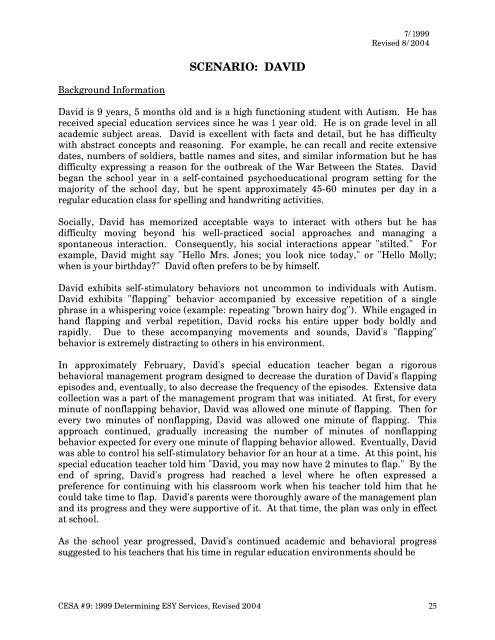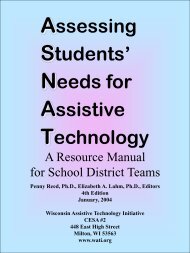Extended School Year Services (ESY) - The Special Education Team
Extended School Year Services (ESY) - The Special Education Team
Extended School Year Services (ESY) - The Special Education Team
Create successful ePaper yourself
Turn your PDF publications into a flip-book with our unique Google optimized e-Paper software.
Background Information<br />
SCENARIO: DAVID<br />
7/1999<br />
Revised 8/2004<br />
David is 9 years, 5 months old and is a high functioning student with Autism. He has<br />
received special education services since he was 1 year old. He is on grade level in all<br />
academic subject areas. David is excellent with facts and detail, but he has difficulty<br />
with abstract concepts and reasoning. For example, he can recall and recite extensive<br />
dates, numbers of soldiers, battle names and sites, and similar information but he has<br />
difficulty expressing a reason for the outbreak of the War Between the States. David<br />
began the school year in a self-contained psychoeducational program setting for the<br />
majority of the school day, but he spent approximately 45-60 minutes per day in a<br />
regular education class for spelling and handwriting activities.<br />
Socially, David has memorized acceptable ways to interact with others but he has<br />
difficulty moving beyond his well-practiced social approaches and managing a<br />
spontaneous interaction. Consequently, his social interactions appear "stilted." For<br />
example, David might say "Hello Mrs. Jones; you look nice today," or "Hello Molly;<br />
when is your birthday?" David often prefers to be by himself.<br />
David exhibits self-stimulatory behaviors not uncommon to individuals with Autism.<br />
David exhibits "flapping" behavior accompanied by excessive repetition of a single<br />
phrase in a whispering voice (example: repeating "brown hairy dog"). While engaged in<br />
hand flapping and verbal repetition, David rocks his entire upper body boldly and<br />
rapidly. Due to these accompanying movements and sounds, David's "flapping"<br />
behavior is extremely distracting to others in his environment.<br />
In approximately February, David's special education teacher began a rigorous<br />
behavioral management program designed to decrease the duration of David's flapping<br />
episodes and, eventually, to also decrease the frequency of the episodes. Extensive data<br />
collection was a part of the management program that was initiated. At first, for every<br />
minute of nonflapping behavior, David was allowed one minute of flapping. <strong>The</strong>n for<br />
every two minutes of nonflapping, David was allowed one minute of flapping. This<br />
approach continued, gradually increasing the number of minutes of nonflapping<br />
behavior expected for every one minute of flapping behavior allowed. Eventually, David<br />
was able to control his self-stimulatory behavior for an hour at a time. At this point, his<br />
special education teacher told him "David, you may now have 2 minutes to flap." By the<br />
end of spring, David's progress had reached a level where he often expressed a<br />
preference for continuing with his classroom work when his teacher told him that he<br />
could take time to flap. David's parents were thoroughly aware of the management plan<br />
and its progress and they were supportive of it. At that time, the plan was only in effect<br />
at school.<br />
As the school year progressed, David's continued academic and behavioral progress<br />
suggested to his teachers that his time in regular education environments should be<br />
CESA #9: 1999 Determining <strong>ESY</strong> <strong>Services</strong>, Revised 2004 25











